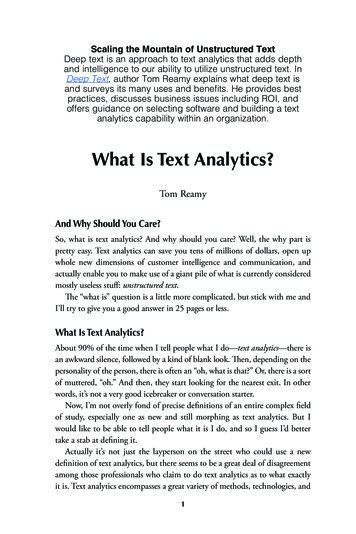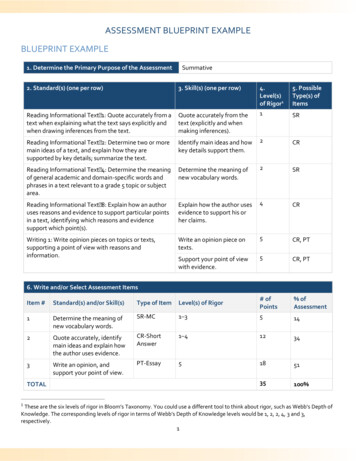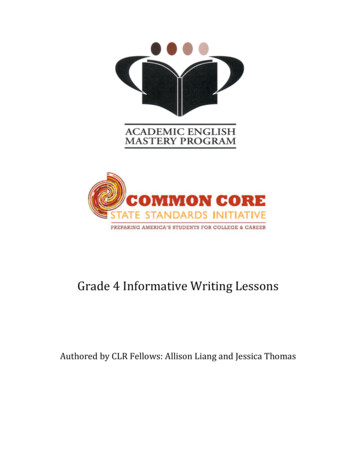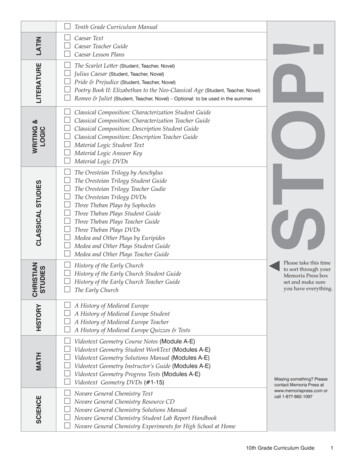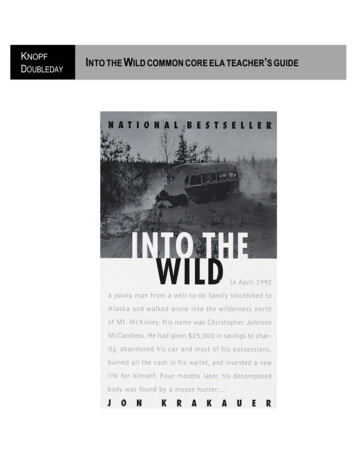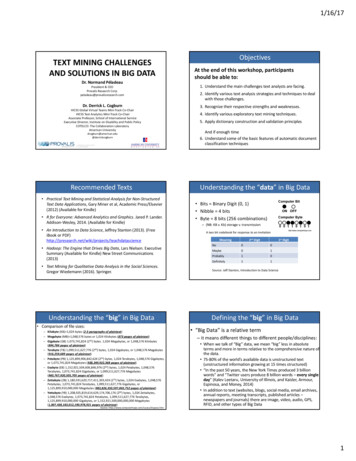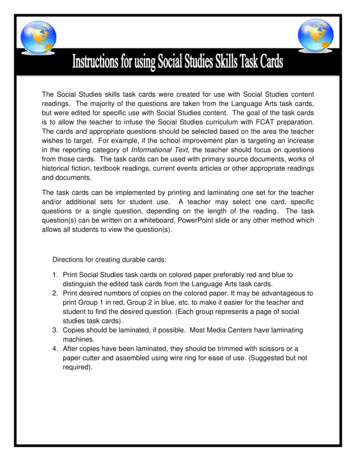
Transcription
The Social Studies skills task cards were created for use with Social Studies contentreadings. The majority of the questions are taken from the Language Arts task cards,but were edited for specific use with Social Studies content. The goal of the task cardsis to allow the teacher to infuse the Social Studies curriculum with FCAT preparation.The cards and appropriate questions should be selected based on the area the teacherwishes to target. For example, if the school improvement plan is targeting an increasein the reporting category of Informational Text, the teacher should focus on questionsfrom those cards. The task cards can be used with primary source documents, works ofhistorical fiction, textbook readings, current events articles or other appropriate readingsand documents.The task cards can be implemented by printing and laminating one set for the teacherand/or additional sets for student use. A teacher may select one card, specificquestions or a single question, depending on the length of the reading. The taskquestion(s) can be written on a whiteboard, PowerPoint slide or any other method whichallows all students to view the question(s).Directions for creating durable cards:1. Print Social Studies task cards on colored paper preferably red and blue todistinguish the edited task cards from the Language Arts task cards.2. Print desired numbers of copies on the colored paper. It may be advantageous toprint Group 1 in red, Group 2 in blue, etc. to make it easier for the teacher andstudent to find the desired question. (Each group represents a page of socialstudies task cards).3. Copies should be laminated, if possible. Most Media Centers have laminatingmachines.4. After copies have been laminated, they should be trimmed with scissors or apaper cutter and assembled using wire ring for ease of use. (Suggested but notrequired).
CONTENTSSOCIAL STUDIES Skills TASK CARDS: Grades 1-12Group 1: ANALYSIS GRAPHIC DATA AND IMAGESSUPPORTING A POSITIONANALYZING PRIMARY AND SECONDARY SOURCESRECOGNIZING BIASGroup 2: PROBLEM SOLVINGGEOGRAPHIC LITERACYDECISION MAKINGIDENTIFYING FRAME OF REFERENCE AND POINT OF VIEWGroup 3: SEQUENCINGUSING RELIABLIE INFORMASTIONEDITORIAL CARTOON ANALYSISTask Cards aligned to Language Arts Benchmarks: Grades 1&2Grades 1-2 Group 1 SAT-10 FUNCTIONALSAT-10 INFORMATIONALGrades 1-2 Group 2 SAT 10 - INFORMATIONALSAT 10 - LITERARYTask Cards aligned to Language Arts Benchmarks:Grades 3-5 Group 1 VOCABULARY - (LA.3-5.1.6.3, 1.6.7, 1.6.8, 1.6.9)AUTHOR’S PURPOSE & PERSPECTIVE - (LA.3-5.1.7.2)MAIN IDEA - (LA.3-5.1.7.3)CHRONOLOGICAL ORDER - (LA.3-5.1.7.3)
Grades 3-5 Group 2 CAUSE & EFFECT - (LA.3-5.1.7.4)RELEVANT SUPPORTING DETAILS - (LA.3-5.1.7.3)TEXT STRUCTURES/ ORGANIZATIONAL PATTERNS - (LA.3-5.1.7.5)THEME/ TOPIC - (LA.3-5.1.7.6)Grades 3-5 Group 3 COMPARE & CONTRAST - (LA.3-5.1.7.7)DESCRIPTIVE, IDIOMATIC & FIGURATIVE LANGUAGE - (LA.3-5.2.1.7)TEXT FEATURES- In Literary Text - LA.3-5.2.2.1)LOCATE /INTERPRET /ORGANIZE INFORMATION & TEXT FEATURESin Informational Text (LA.3-5.6.1.1)Grade 5 *ONLY* VALIDITY & RELIABILITY - (LA.5.6.2.2) - *Grade 5 onlyTask Cards aligned to Language Arts Benchmarks:Grades 6-8 Group 1 MAIN IDEA - (LA.6-8.1.7.3)PATTERNS OF ORGANIZATION- TEXT STRUCTURE-(LA.6-8.1.7.5)CHARACTER & PLOT DEVELOPMENT- POINT OF VIEW/SETTING CONFLICTRESOLUTION-(LA.6-8.2.1.2)VALIDITY & ACCURACY OF INFORMATION- (LA.6-8.6.2.2)Grades 6-8 Group 2 COMPARE/ CONTRAST- (LA.6-8.1.7.7)ANALYZE AND EVALUATE/SYNTHESIZE INFORMATION - (LA.6-8.6.2.2)AUTHOR’S PURPOSE/ PERSPECTIVE - (LA.6-8.1.7.2)TEXT FEATURES IN INFORMATIONAL/LITERARY TEXT -(LA.6-8.6.1.1,LA.6-8.2.2.1)
Grades 6-8 Group 3 CAUSE/ EFFECT- (LA.6-8.1.7.4)VOCABULARY (LA.6-8.1.6.3, LA.6-8.1.6.7, LA.6-8.1.6.8, LA.6-8.1.6.9, LA.6-8.1.6.11DESCRIPTIVE, IDIOMATIC, and FIGURATIVE LANGUAGE (LA.6-8.2.1.7)Task Cards aligned to Language Arts Benchmarks:Grades 9-12 Group 1 PRIMARY SOURCE- POINT OF VIEW/ SETTINGCONFLICTRESOLUTIONTONE(LA.910.2.1.5, LA.910.2.1.7)DESCRIPTIVE, IDIOMATIC FIGURATIVE LANGUAGE(LA.910.2.1.7)TEXT FEATURES- (LA.910.2.2.1)CAUSE/ EFFECT - (LA.910.1.7.4)Grades 9-12 Group 2 MAIN IDEA - (LA.910.1.7.3)TEXT STRUCTURE/ORGANIZATIONAL PATTERNS - (LA.910.1.7.5)COMPARE/ CONTRAST - (LA.910.1.7.7)AUTHOR’S PURPOSE & PERSPECTIVE - (LA.910.1.7.2)Grades 9-12 Group 3 SYNTHESIZE INFORMATION- (LA.910.6.2.2)ANALYZE & EVALUATE INFORMATION -(LA.910.6.2.2)VALIDITY & RELIABILITY OF INFORMATION -(L.A.910.6.2.2)TEXT FEATURES - ( LA.910.6.1.1)
SOCIAL STUDIES TASK CARDTask: Analyzing Graphic Data and ImagesAnalyzing a GraphBasic steps:1. Read the title.2. Read the labels and the legend, if any.3. Look for similarities, differences, increases or decreases.4. Make a general statement about what the graph shows.Questions: What is the title of the graph? What do the labels or legend show? What type of graph is this? (bar, circle, line) What similarities or differences are shown on the graph? What increases or decreases are shown on the graph? What is the graph measuring or showing?Analyzing ImagesBasic Steps:1. Ask who or what the image is showing.2. Ask when and where the scene takes place.3. Ask what general feeling you get from the image.4. Ask who created the image and why.Questions: What is the caption of the image? Is the image a painting, photograph, poster, cartoon or sculpture? When and/or where does the scene take place? What details stand out in the image? What people, places or things do you recognize in the image? What mood (happiness, sadness, fear, patriotism, etc.) do you get SOCIAL STUDIES TASK CARDTask: Supporting a PositionBasic steps:1. Support your position clearly in a sentence.2. Identify at least three reasons.Think of what will best persuade your audience.Think of reasons for your side or against the otherside.3. Support each reason with accurate evidence.4. Put your reasons and supporting evidence in an effective order.5. Add a conclusion.Questions: What is your position on this issue/article/political candidate,etc.? What are three reasons you feel this way? What are some arguments you might make if someonedisagrees with your position? What evidence do you have to support your position? How can you best sum up your position in a concludingstatement?from the image?Who created this image?Why was this image created?SOCIAL STUDIES TASK CARDTask: Analyzing Primary and Secondary SourcesSOCIAL STUDIES TASK CARDTask: Recognizing BiasRecognizing BiasBasic steps:1. Identify who created the source, when, and why.2. Identify the main idea.3. Separate facts from opinions. What do you learn from each?4. Look for evidence of bias, or a one-sided view, often expressedin emotionally “charged” words.5. Evaluate how reliable the source is.Questions: Who created the source? When and why was the source created? Is this a primary source or a secondary source? What is the main idea presented in the source? What are some examples of facts presented in the source? What are some examples of opinions presented in the source? Are there any examples of bias in the source? Is this a reliable source? What are the criteria you used to judgewhether or not this is a reliable source?Primary Source: information from someone who actually experienced what is beingdescribed. Examples are diaries, letters, autobiographies, photos, paintings, recordings,video tapes, interviews.Secondary Source: Information from someone who did not experience what is beingdescribed. Examples are biographies, history books, articles, textbooks, encyclopedias.1.2.3.4.5.Questions: Basic steps:Judge if any facts are incorrect or left out.Look for emotionally charged words that sound good or bad.Identify who expresses the bias and why.State the bias in your words.Determine how the bias affects the information.Do any of the facts seem incorrect? Was any important information left out?What are some examples of emotionally-charged words in thepassage/article/story?Who expresses bias in the passage/article/story? Why might that individual bebiased?How might you restate the biased words?How does the bias in the passage/article/story affect the information presented?Recognizing PropagandaBasic steps:1.Identify exaggerations or information that is ignored.2.Identify emotional appeals, such as symbols, “charged” words, or the sense ofbelonging to a group.3.Identify who created the propaganda and why.4.Determine if the propaganda seems effective.Questions: What are some examples of exaggerated information in this document,advertisement, etc.? Is there any information that is left out, but should be included? What are some examples of the use of emotional appeals? Who created this and for what purpose? Is this passage/story/article/advertisement/slogan effective?Bias: a one-sided or slanted view.Propaganda: the spreading of one-sided information to influence public opinion and action. The propaganda is used inadvertising and politics.
SOCIAL STUDIES TASK CARDTask: Problem SolvingBasic steps:1. Identify the problem2. Determine the impact or effect of the problem3. Identify possible solutions to the problem4. Analyze/Evaluate the effectiveness of a solutionQuestions: What is or was the problem? What is or was the impact or effect of the problem? What are or were some possible solutions to the problem? What solution is or was suggested and how effective is or wasit?SOCIAL STUDIES TASK CARDTask: Decision MakingBasic Steps:1. Identify the problem.2. List the options.3. Evaluate, or judge, each option.Identify good and bad points.Determine which points are most important.4. Choose the option that seems best.Questions: What is the problem/decision to be made? What options are available? What are the good points and bad points of each option? Which of these points is the most important? Which option is the best?SOCIAL STUDIES TASK CARDTask: Geographic LiteracyBasic steps:1. Identify the topic of the map.2. Identify the symbols used in the legend.3. Use the grid to find examples of absolute location (latitude andlongitude.)4. Determine the purpose or use for this map.Questions: What type of map is this? What does the key or legend show? What would this map be used for? What are some examples of information you can find on thismap? What conclusions can you draw from the information on thismap?SOCIAL STUDIES TASK CARDTask: Identifying Frame of Reference andPoint of ViewBasic steps:1. State the topic or issue.2. Determine the person’s position on the topic or issue.3. Identify what you know about the person’s frame of reference.4. Ask how the person’s frame of reference may have influencedhis or her beliefs.Questions: What is or was the topic or issue? What is or was the person’s position on the topic or issue? Howdo you know what the person’s position on the topic or issue is? What is or was this person’s frame of reference? How did this person’s frame of reference influence his or herposition or beliefs?
SOCIAL STUDIES TASK CARDSequencingCreating a TimelineBasic steps:1. Determine the topic and the time span.2. Identify events that relate to the topic.3. Place the events in time order, with a date next to each event.In addition to dates, look for “time words” as clues, such asbefore and later.4. Make a line that:has a beginning and an end date.is divided into equal sections.has labels identifying each event.Questions: What is the topic and time span to be covered in the timeline? What events relate to the topic? In what order did the events occur?Creating a FlowchartBasic Steps:1. Give the process a title and identify the main steps.2. Reword each step briefly.3. Place the steps in time order.4. Choose a type of flowchart.5. Write the steps in flowchart boxes and add the arrows.SOCIAL STUDIES QUESTION TASK CARDSEDITORIAL CARTOON ANALYSIS What is the event or issue that inspired the cartoon? Are there any real people or places in the cartoon? If not, whatimages are portrayed in the cartoon? Identify the specific artistic techniques used in the cartoon (i.e.,symbolism, analogy, exaggeration, labeling, and irony). What is theartist trying to show the reader by using these techniques? What is the cartoonist's point of view about the topic portrayed in thecartoon? Give examples to support your interpretation. Is this cartoon persuasive? Explain why or why not. What other techniques could the artist have used to make thiscartoon more persuasive?SOCIAL STUDIES TASK CARDTask: Using Reliable InformationChecking Whether a Source is ReliableBasic steps:1. Is the information recent enough for your purpose?2. Is the information accurate? Does it agree with sources youalready know are reliable?3. What are the author’s qualifications and methods?4. Why is the author writing about the subject? Does he or shehave a bias, or a one-sided view?Questions: What is the publication date of the source? When was this website last updated? How does the information presented in this source comparewith information you have found in other sources? Does the information appear to be accurate? What qualifies the author to write this article/ passage/website? What method did the author use to gather information? Does the author have a motive to write thisstory/passage/article? Does the author give a balanced view?
Grades 1 & 2 SAT-10Social Studies Question Task Cards –FunctionalInitial UnderstandingAsk a question that requires students to simply locatedetails or identify chronological order. The answers areright there in the poster, chart, flyer, or recipe. Who, what, when, where, how many, or how much?According to the , what will thechildren learn?What do you do first/last?What did he/she do first/last?Where did go before/after ?Which was seen first/last?Step # tells .The story tells you that . solution is or was suggested and how effective is or was it? Grades 1 & 2 SAT-10Social Studies Question Task Cards –FunctionalInterpretationAsk a question that requires students to drawconclusions from the information given, apply ideas fromtext to a new situation, or determine the main idea. Who, what, when, where, how many, or how much? Why did have ? How did do ? What might be funny? (ha ha) Why do you think ? Why should ? About how long will it take to ? What makes ? To make you will need . Which of these is true?Grades 1 & 2 SAT-10Social Studies Question Task Cards –FunctionalCritical Analysis and StrategiesAsk a question that requires students to determine theauthor’s purpose/viewpoint, identify text characteristics,or if needed information is within the text. The was written mainly to .Which of these is true?What does the author want you to know?Grades 1 & 2 SAT-10Social Studies Question Task Cards –InformationalInitial UnderstandingAsk a question that requires students to simply locateexplicit details and chronological order that are rightthere in the expository text. Who, what, when, where, how many, or how much?What does the story say about ?The story says that .Which of these happened first/last?Which of these happened only once?What happened ?At the end of the story, ?
Grades 1 & 2 SAT-10Social Studies Question Task Cards –InformationalInterpretationAsk a question that requires students to make inferencesto draw conclusions, determine main idea, orcause/effect relationships. Which of these is the best name for this story?What is the main idea of the story?What is this story about?Which of these is true?Which of these is true in the story?Why does have ?What causes to happen?Grades 1 & 2 SAT-10Social Studies Question Task Cards –InformationalCritical Analysis and Strategies (2nd grade only)Ask a question that requires students to determine theauthor’s purpose/viewpoint and unknown words incontext. Grades 1 & 2 SAT-10Social Studies Question Task Cards LiteraryGrades 1 & 2 SAT-10Social Studies Question Task Cards LiteraryInitial UnderstandingAsk a question that requires students to locate explicitdetails and chronological order that are right there instories, personal narratives, or text. Who, what, when, where, how many, or how much?What does the story say about .?The story says that .Which of these happened first/last?Which of these happened only once?What happened ?At the end of the story, ?Which of these does the author probablybelieve?The author wrote this story mainly to ?How can you tell that ?InterpretationAsk a question that requires students to make inferencesin order to draw conclusions, determine main ideas, orcause/effect relationships. Which of these is the best name for this story?What is the main idea of the story?Why does have ?probably does because .This story is mostly about .You can tell that likes because .Who had probably ?How do you know ?
SOCIAL STUDIES QUESTION TASK CARDSVOCABULARY(LA.3-5.1.6.3, 1.6.7, 1.6.8, 1.6.9)Author’s PurposeContext Read this sentence from the passage.““mean?What does the wordSynonyms/Antonyms What word means the SAME as? Choose the word that means the OPPOSITE ofSOCIAL STUDIES QUESTION TASK CARDSAUTHOR’S PURPOSE & PERSPECTIVE(LA.3-5.1.7.2) .Affixes/Base Words or Root Words? Which word has the same base word as If (base word) means, what does base word affix mean? Based on the prefix and base word what does mean?Multiple Meaning Which sentence below uses the wordthe same way as thestory/article? Which sentence uses the wordthe same as it is used in thesentence above?Why does the author most likely write the story/passage?What is the author’s purpose in writing this article?andwrite theseWhy did the authors ofstories/articles?Author’s Perspective? What does the author mean when he/she writesof most likely read in Which books would the authororder to write this article/story? With which statement would the author most likely agree? Explain what the author thinks is most important about.Analyze Words in Text What feeling does the wordcreate? What does the author mean when he/she says? Why does the author use the wordin the sentence above?SOCIAL STUDIES QUESTION TASK CARDSMAIN IDEA(LA.3-5.1.7.3) What is the MAIN IDEA of this story/passage/article?”?Why do you think this story/article has the title “What would be another good title for this story?Which sentence best tells what the passage is about?What is the essential message in the story/article?Which sentence from the article tells the author’s main messageWhat is the primary topic of the article?Which sentence gives the best summary?Which accomplishment/idea is the most valuable?SOCIAL STUDIES QUESTION TASK CARDSCHRONOLOGICAL ORDER(LA.3-5.1.7.3) ?What happened just BEFORE/AFTERWhat happened first, last, etc. ?but BEFORE?What happens AFTERand?What happened between?What is the first step inRetell the events leading up to/following .Explain the steps for and the reasons why.According to the article, what happened first?
SOCIAL STUDIES QUESTION TASK CARDSRELEVANT SUPPORTING DETAILS(LA.3-5.1.7.3)SOCIAL STUDIES QUESTION TASK CARDSCAUSE & EFFECT(LA.3-5.1.7.4)Cause Effect toWhat causedWhat are the events that causeddecide toWhy doesprobably choosesbecause . ?Which is a way to improve?Which detail from the article helps show how ?support the idea that?How doesoffer to?Why doesover?What might happen ifWhat were the results of (an event or action)?have onWhat effect did?What is the effect ofabove?SOCIAL STUDIES QUESTION TASK CARDSTEXT STRUCTURES/ ORGANIZATIONAL PATTERNS(LA.3-5.1.7.5)*Identify the text structure an author uses and explain how it impactsmeaning. (e.g., compare/contrast, cause/effect, chronological order,description)Text Structure What information can be found under the?heading How does the author help readers BETTER?understand Explain what the author does to make the information ineasier to understand.? How does the author mostly explainOrganizational Patternsto . The author organized the section Which statement below lets the reader know how the authororganized the passage? Why did the author begin the article/story with ? At the end of the passage/article/story, why does the authorrepeat ? Why did the author include the description of in thearticle/story?SOCIAL STUDIES QUESTIONS TASK CARDSTHEME/ TOPIC(LA.3-5.1.7.6)* Identify themes or topics within a variety of text.Topic What topic is covered in the article/passage?What information does the author use to support the main topicof this article/passage?Explain the topic of this passage.Themein the passage? What is a positive result of What is the best lesson that can be learned from this passage?
SOCIAL STUDIES QUESTION TASK CARDSCOMPARE/ CONTRAST(LA.3-5.1.7.7)CompareandALIKE? How areand What are the SIMILARITIES between What is the author comparing in the sentence above? What do and have in common?both SIMILAR to and DIFFERENT How isfrom?SOCIAL STUDIES QUESTION TASK CARDSDESCRIPTIVE, IDIOMATIC & FIGURATIVE LANGUAGE(LA.3-5.2.1.7)?ContrastDIFFERENT from? How isand? What is one DIFFERENCE betweensimilar/ dissimilar to? How is What are the DIFFERENCES between and ?DIFFERENT How is the information infrom? What advantage does have over ?SOCIAL STUDIES QUESTIONS TASK CARDSTEXT FEATURESIn Literary Text(LA.3-5.2.2.1) Which sentence from the article/passage/story best describesthe illustration on page ?, is toThe purpose of the illustration on pageshow the reader.What information are you most likely to find in?the section titledThe illustrations are important to the passage because.theyDescriptive Language What tone does the author create by using the phrase?.Explain how an author creates a mood of(weariness/excitement/hopefulness)Figurative Language How is the author comparing to ?“Read the sentence from the passage: “What characteristic applies to and ?What does it mean to ? (Interpret an idiom in context)Why did the author begin the story/article with ?At the end of the passage/story/article, why does the authorrepeat ?SOCIAL STUDIES QUESTIONS TASK CARDSLOCATE /INTERPRET /ORGANIZE INFORMATION& TEXT FEATURESin Informational Text(LA.3-5.6.1.1)Locate/Interpret/Organize Information By reading the article and looking at the map, you can tell thatandare located. Based on the article, what is the purpose for the, , and listed in the section?Text Features Under which heading would you MOST LIKELY find?information on Why are there lines and numbers on the picture of? How does the footnote for the word help thereader better understand the information in the passage? What is the purpose of the check marks used in the?section What is the purpose of the subheadings listed under? What is the purpose of the illustration at thebeginning/end of the article?
SOCIAL STUDIES QUESTIONS TASK CARDSVALIDITY & RELIABILITY(LA.5.6.2.2)*Grade 5 only For what could the information in the article/passage best beused?What does the author use to support the information inthe article/passage?What information from the article supports the?conclusion thatWhat are the reasons behind the author’s opinion that?According to the information, what is the MOST VALID?argument for?Which statement best supports the idea that?What is the greatest benefit of?What evidence supports
SOCIAL STUDIES QUESTION TASK CARDSMAIN IDEA(LA.6-8.1.7.3)MAIN IDEA What is the main idea of this article? What would be another good title for the article? Which accomplishment/idea was most valuable? Which sentence gives the best summary? What is the primary topic in the article? What is the essential message in the article/story? What is the central idea of the article? What is the main goal of If the article were published in a newspaper, which headlinebest expresses the main idea?, how does think was created? Based onRELEVANT SUPPORTING DETAILS Which sentence best characterizes?support the idea that How does How can the reader prove the idea thatidea of this text? What events from the passage show that‘s attitude toward?is the mainis?CONCLUSIONS/INFERENCES Based on the introductory paragraph, what can the reader?conclude about“ Read this quotation from . ”In the quotation above, is indicating that .SOCIAL STUDIES QUESTION TASK CARDSCHARACTER & PLOT DEVELOPMENTPOINT OF VIEW/SETTINGCONFLICT RESOLUTION(LA.6-8.2.1.2)CONFLICT What is the main conflict in the article/passage? When is the central conflict between andintroduced in the article?RESOLUTION What in the passage indicates that the conflict is resolved?SOCIAL STUDIES QUESTION TASK CARDSPATTERNS OF ORGANIZATIONTEXT STRUCTURE(LA.6-8.1.7.5)ORGANIZATIONAL PATTERNS What would an additional paragraph at the end of this passagemost likely be about?in paragraph What is the connection betweenand in paragraph?and? Why does the author connect the ideas of? Why did the author begin this passage by sayingto develop this text? Why did the author use Why did the author conclude this passage by saying “ ?”had been changed to? What would happen if? What happened after How did the author organize the paragraph? How does the author organize the information in this flyer? How does the author’s organization of information in thebrochure help prepare for ?TEXT STRUCTURE The section is different from the other sections of thewebsite because it . How has the order in which the author arranged this passagehelped the reader understand?aboutSOCIAL STUDIES QUESTION TASK CARDSVALIDITY & ACCURACY OF INFORMATION(LA.6-8.6.2.2) based?On which facts are the opinions aboutWhat are the reasons behind the author’s opinion that ?How does the author use (word, phrase, etc.) to strengthen the?opinion/argument thatAccording to the information, what is the MOST VALID argument for?Which statement from the article best supports the idea that ?Which statement is best supported by information from the article?Which sentence from the flier best supports why ?What is the greatest benefit ofWhat evidence supports ?What is the best evidence thatWhich sentence from the brochure best emphasizes ?Based on the information in the article, which is the most accuratestatement regarding ?The author supports his/her statements about by using.Which aspect of contributes most to ?
SOCIAL STUDIES QUESTION TASK CARDSCOMPARE/ CONTRAST(LA.6-8.1.7.7)COMPAREandsimilar? How areandin this passage? Why does the author compareandhelp to How does the comparison betweenillustrate?andhave in common? What do‘s attitude towardlike his/her attitude toward How is?an appropriate comparison? In what way is Which sentence gives the best description of how anddeal with ? Read this sentence from the passage.“ ”Based on the sentence above, in what way is/are similarto ? Explain the similarities between and ?SOCIAL STUDIES QUESTION TASK CARDSANALYZE AND EVALUATE/SYNTHESIZE INFORMATION(LA.6-8.6.2.2)ANALYZE AND EVALUATE The information in the article/passage would be most useful for. Explain how the various types of information found in thebrochure will guide a reader in . Which characteristics are used to classify and ? People who read this article/passage will learn to/that ?SYNTHESIZE Which aspects of the brochure are most helpful for? Based on all information given, how does each part add to the?idea thatandsuggest the central idea that? How doCONTRASTanddifferent? How arehave over? What advantage didhave morethan ? Why did When the passage begins, how is ’s view different from’s?SOCIAL STUDIES QUESTION TASK CARDSAUTHOR’S PURPOSE/ PERSPECTIVE(LA.6-8.1.7.2)AUTHOR’S PURPOSE? How does the author persuade the reader to? What is the author’s purpose for saying. The author wants the reader to think What kind of article did the author write about ? Why does the author describe in way? Read this excerpt from the passage.“ ”In the excerpt above, the author lists specific in order to. What is the author’s most likely purpose for writing this article?AUTHOR’S PERSPECTIVE Which statement best describes what the author probably thinks?about With which statement would the author most likely agree?to? How does the author’s experience lead? What is the author’s point of view about Which feature would the author value the most? What is the author’s attitude towardis viewed by the author as. SOCIAL STUDIES QUESTION TASK CARDSTEXT FEATURES IN INFORMATIONAL/LITERARY TEXT(LA.6-8.6.1.1, LA.6-8.2.2.1)TEXT FEATURES IN INFORMATIONAL TEXT Why did the author use subtitles in the passage? How does the caption under the photograph help the reader tounderstand ? How does the photograph of help the readerunderstand ? How do the photograph(s) and caption(s) help the readerunderstand ? Explain how the (chart/ map/ diagram/ sub-heading/ caption/illustration/ graph) aid the reader’s understanding. Based on the passage, which sentence would best serve as acaption for the illustration on page ? Based on the map and the italicized introduction, what can thereader conclude about and ? Which text features of the website offers the most accurateinformation about ? The purpose of the brochure’s bold-print heading andsubheadings is to inform readers about .TEXT FEATURES IN LITERARY TEXT The timeline is important to the passage because it
The Social Studies skills task cards were created for use with Social Studies content readings. The majority of the questions are taken from the Language Arts task cards, but were edited for specific use with Social Studies content. The goal of the task cards is to allow the teacher to infuse the Social Studies curriculum with FCAT preparation.

